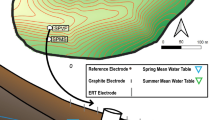Abstract
OXIDATION-REDUCTION or redox potential measurements have been widely used in the study of chemical and biological reactions in waterlogged soils. The oxidation-reduction potential is used to characterize aeration in waterlogged soils because the more commonly used measurements of oxygen concentration and oxygen diffusion rate are of little value. Dissolved oxygen is usually completely absent or present in very low concentration in a waterlogged soil.
Similar content being viewed by others
References
Knight, B. C. J. G., Biochem. J. (London), 24, 1075 (1930).
Hanke, M. E., and Katz, Y. J., Arch. Biochem., 2, 183 (1943).
Kefauver, M., and Allison, F. E., J. Bacteriol., 73, 8 (1957).
Author information
Authors and Affiliations
Rights and permissions
About this article
Cite this article
PATRICK, W. Apparatus for controlling the Oxidation-reduction Potential of Waterlogged Soils. Nature 212, 1278–1279 (1966). https://doi.org/10.1038/2121278a0
Published:
Issue Date:
DOI: https://doi.org/10.1038/2121278a0
- Springer Nature Limited
This article is cited by
-
Trace Element Solubility in a Multimetal-Contaminated Soil as Affected by Redox Conditions
Water, Air, & Soil Pollution (2014)
-
The production of hydrogen sulphide in peats
Folia Microbiologica (1974)
-
Effect of Redox Potential on Manganese Transformation in Waterlogged Soil
Nature (1968)





